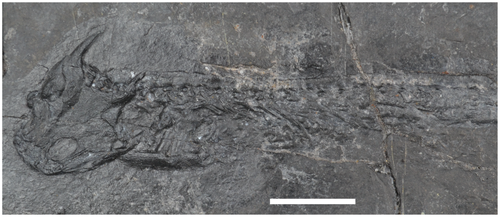Lagerstätte is a German term that means "storage place" or "depository". In the context of paleontology, it refers to a site where exceptionally well-preserved fossils have been found. These fossils can provide valuable information about the organisms and the environment in which they lived. Lagerstätte is considered to be very rare and is often of great interest to scientists.
However, new research suggests that there may be another explanation for the strange preservation of the bones in the Jarrow Assemblage. A team of scientists from Ireland and the United Kingdom has proposed that the bones may have undergone a process called diagenesis, in which chemical reactions alter the structure of the bones over time.
This process can preserve the internal structure of the bones and make it difficult to distinguish the details of the original organisms. The researchers believe that the conditions at the Jarrow Assemblage may have been ideal for this process to occur, leading to the strange preservation of the bones. Further research will be needed to confirm this hypothesis and to better understand the processes involved in the preservation of fossils at the Jarrow Assemblage.
Preservation Process
The research suggests that the Jarrow Assemblage bones were not preserved by acidic waters or achieved fossilization, as previously thought. Instead, they were subjected to extremely high temperatures that altered their internal structure. The researchers believe that the bones were buried in a coal swamp and then exposed to superheated fluids that seeped into the rock as a result of tectonic activity. This caused the bones to be "cooked" and changed their internal structure, making it difficult to identify the animals they came from.
The study's findings challenge previous assumptions about the preservation of fossils in Lagerstätte and highlight the complex processes that can occur in these environments. The researchers say that their work could have implications for the study of other Lagerstätte and the organisms they contain, as reported by Science Alert.
The researchers used a variety of techniques to study the chemistry of the Jarrow bones and determine the cause of their unique preservation. They combined high-resolution imaging with techniques to analyze the elemental composition and structure of the bones and found that the chemical makeup of the bones was different from that of typical bones. The team, led by paleontologist Aodhán ó Gogáin of Trinity College Dublin in Ireland, concluded that the preservation of the bones was largely due to hydrothermal fluids during deep burial and was not the result of environmental conditions during the initial stages of burial or early diagenesis.
To the researchers, the bones at Jarrow were not preserved in their original form. Instead, they had been partially replaced by coal and sphalerite, a mineral that forms in hydrothermal conditions. In addition, the apatite crystals in the bones were of a different form than those typically found in bones. This suggests that the preservation of the bones was influenced by factors other than the normal process of burial and early diagenesis. Geologist Gary O'Sullivan of Trinity College Dublin said that the chemical composition of the apatite crystals can provide valuable insights into the processes that led to the bones' unique preservation.

Found Apatite Crystal
The team also found that the apatite crystals in the Jarrow bones had been formed by hydrothermal fluids, which are superheated waters that come from beneath Earth's crust. These fluids heated the rock around the bones to temperatures of around 300 to 350 degrees Celsius (572 to 662 degrees Fahrenheit), melting the apatite crystals in the bones. As the bones cooled, the apatite recrystallized into the tabular form observed by the scientists. This theory was confirmed by radiometric dating, which showed that the apatite crystals were around 302 million years old.
Overall, the researchers concluded that the unique preservation of the bones at Jarrow was due to the influence of hydrothermal fluids during deep burial. The apatite found in the fossils of Ireland shows that it formed when the continents on Earth were colliding to form the supercontinent Pangaea. As the continents collided, mountain belts were formed with superheated fluids flowing from them. It is these superheated fluids that flowed throughout Ireland, cooking and melting the bones of the fossils and causing the alteration seen today, as emphasized by ó Gogáin.
The research team proposes that the bones of the fish and tetrapods found in Jarrow were transported a short distance and buried rapidly, which preserved their almost complete skeletons and scaly skins. However, the bones became fractured during the burial process, allowing hydrothermal fluids to infiltrate and alter their chemistry and structure. This phenomenon is unique to Jarrow and provides insight into the history of the formation and its bones.
Paleontologist Patrick Wyse Jackson of Trinity College Dublin comments that the Jarrow assemblage is of major scientific importance and is a significant element of Ireland's heritage. It is great that finally the inquiry of what varied the fossil bones of such species has been concluded. The research has been published in the journal Palaeontology.
RELATED ARTICLE: Paleontologists Discovered Ancient Snouted Arthropod Relatives That Possibly Fragments From the Cambrian Explosion
Check out more news and information on Paleontology in Science Times.











